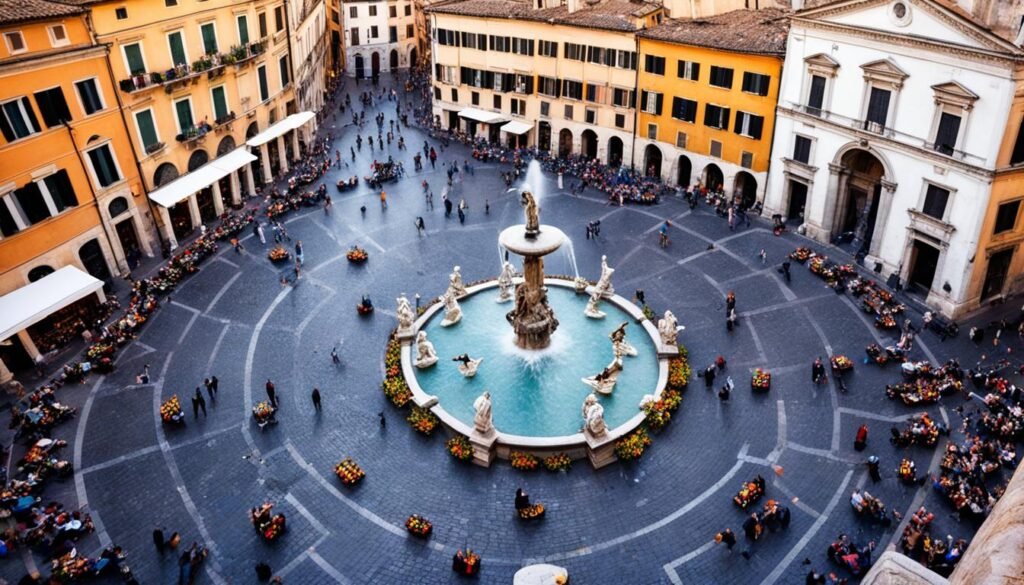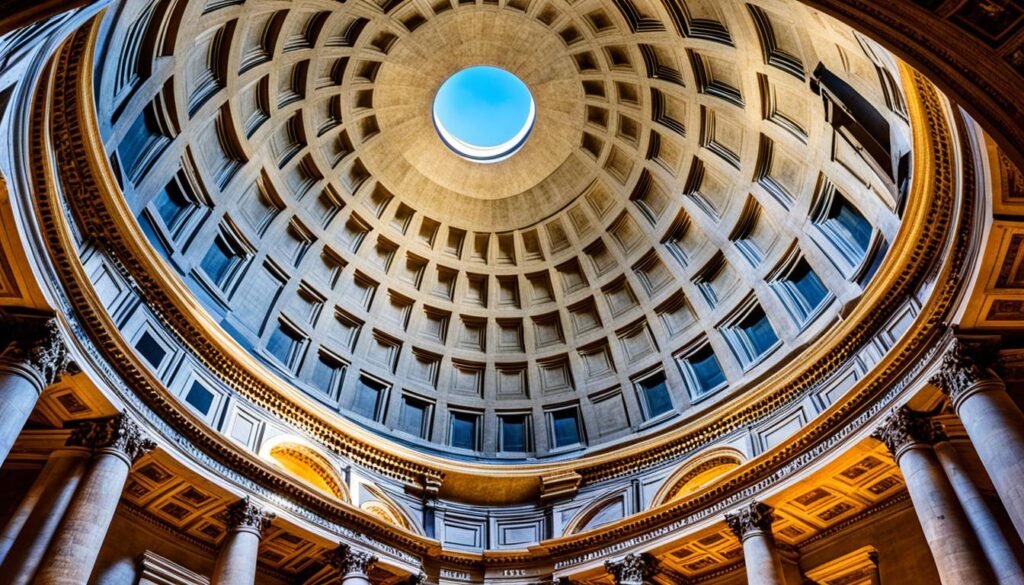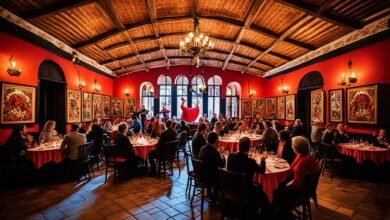Table of Contents
When you visit Rome, you can see some of the world’s most famous cultural sites. The Colosseum and Roman Forum show ancient history’s grandeur. Sites like St. Peter’s Basilica and Pantheon show Rome’s architectural wonders.
The Trevi Fountain, Piazza Navona, and Spanish Steps reflect Rome’s baroque and romantic periods. These places give you a look into Rome’s rich history, capturing the hearts of people worldwide.
Iconic Roman Landmarks: A Journey Through History
Rome is famous for its rich history and iconic cultural sites. You can see the grand architecture of the past and the beauty of the Renaissance and Baroque periods. Each landmark shares a piece of the city’s vibrant history.
The Eternal City’s Most Treasured Sites
Visit Rome’s most famous sites like the Colosseum, Roman Forum, and Trevi Fountain. Each place, from the Pantheon to St. Peter’s Basilica, holds unique stories and secrets. They stand as symbols of architectural excellence.
Uncovering Ancient Marvels and Architectural Wonders
Step into Rome’s history and see how ancient times mix with the modern. Admire the ancient Roman architecture and the lavish Renaissance and Baroque structures. Each landmark is a living story of the city’s long journey.
The Colosseum: A Gladiatorial Amphitheater for the Ages
The Colosseum in Rome stands as a symbol of the ancient Roman Empire‘s power. It was built more than 2,000 years ago. This amphitheater hosted legendary gladiator contests and shows for the public.
Visitors today can follow the paths of these ancient fighters. They can see where they prepared and the animals were kept. It’s an experience that transports you back in time.
This site is not just about entertainment; it showcases the architecture and history of ancient Rome. Its design includes a system of hidden passages and a sun-shielding awning. These features show the Romans’ skills in both engineering and providing for the people.
Today, the Colosseum tells the story of Rome and its gladiators. Millions visit to admire its beauty and understand its past. Explorers can wander through its ancient halls, tunnels, and marvel from the outside. It gives anyone a chance to step into the world of the ancient Romans.
Roman Forum: Heart of the Ancient Empire
The Roman Forum was ancient Rome’s heart for politics and business. It was where government, religion, and daily life thrived. Walking through its ruins, you can sense the activity and life of the past.
Exploring the Political and Commercial Center
You can see grand temples, basilicas, and buildings left from the Roman Empire’s era. They show the Empire’s power and how bustling the economy was. These sites give insight into how the ancient Romans governed and traded.
Preserved Ruins and Monuments of Bygone Eras
Here, the Roman Forum lets you travel back in time. You encounter ruins like the Arch of Titus, the Temple of Saturn, and the Basilica of Maxentius. Strolling around, you can really picture the Forum as the lively core of the ancient empire.
St. Peter’s Basilica: Grandeur of Vatican City
St. Peter’s Basilica sits at the heart of Vatican City, known as a top church globally. It was made by famous artists like Bramante and Bernini. The mix of Renaissance and Baroque styles is stunning.
Iconic Renaissance Architecture and Baroque Splendor
The work features a large dome and detailed ornaments. There’s also the grand Baldacchino. They all add to its amazing sight. The blend of Renaissance and Baroque makes it truly breathtaking.
A Pilgrimage Site of Immense Spiritual Significance
More than just a building, St. Peter’s Basilica is a sacred site for Catholics. It symbolizes the global impact of the Catholic Church. With St. Peter’s remains here, it’s a key place for worship.
Castel Sant’Angelo: A Formidable Fortress and Museum
Castel Sant’Angelo, also called Hadrian’s Mausoleum, is a historic icon. It was first a strong fortress, then a home for Popes, and today, a museum.
This structure sits on the Tiber River’s northern bank. It has seen over 2,000 years of Rome’s history. Visitors can see the original tomb of Emperor Hadrian and the places where Popes hid during dangers. This site shows us Rome’s rich history and the connection between the Roman Empire and Catholic Church.
Exploring Hadrian’s Mausoleum and Papal Apartments
Castel Sant’Angelo stands as a symbol of power and safety in Rome. It invites a look into its past through the Papal Apartments. Here, Popes took safe haven in times of trouble. The site also features Hadrian’s Mausoleum, built for the resting place of Emperor Hadrian.
Walking inside Castel Sant’Angelo is like walking through history. With its many artifacts, it shows Rome as a fortress, a burial site for royals, and a safe place for Popes. It’s a place where architecture, history, and culture meet and greet every visitor.
Trevi Fountain: A Baroque Masterpiece of Marble and Sculpture
The Trevi Fountain is a stunning example of Baroque architecture and marble sculpture. It welcomes thousands of tourists yearly. It’s an iconic Rome landmark from 1726. Artists Nicola Salvi and Gian Lorenzo Bernini worked together to create it. Its detailed marble sculptures and water features make a scene that’s unforgettable in Rome.
Tossing a coin into the Trevi Fountain is a well-loved practice. It’s believed to guarantee you coming back to Rome. This adds to its fame as a beloved iconic landmark of the city. The fountain’s design and craftsmanship stand out from the Baroque era. It’s a key site for anyone wanting to discover Rome’s rich culture.
Piazza Navona: A Vibrant Square Steeped in History
Piazza Navona is in the heart of Rome. It’s known for its beautiful Bernini fountains and Renaissance palaces. This square has been buzzing with life since the 15th century. Much of its charm today is thanks to the works of Gian Lorenzo Bernini.
Bernini’s Fountains and Renaissance Palaces
The Fountain of the Four Rivers and the Pamphili Palace stand tall here. There’s also the Obelisk of Domitian. These are great examples of the square’s lasting beauty, shaped by Renaissance architecture.
A Lively Hub for Art, Culture, and Rome cuisine
Today, Piazza Navona is full of art, music, and amazing food. It’s a lively spot that truly shows Rome’s cultural heritage. In this charming square, you can have a great meal or enjoy local art. It’s a top place to feel the energy of Rome, the Eternal City.

Altare Della Patria: Rome’s Imposing National Monument
The Altare Della Patria, known as the “Wedding Cake,” has a unique mix of Eclectic and Neoclassical styles. It’s in the heart of Rome. This monument is a tribute to Italy’s unification.
It shines with a white marble look and grand stairs. You can’t miss it in Piazza Venezia.
The “Wedding Cake” and Its Unique Architecture
Inside, visitors can see the detailed Tomb of the Unknown Soldier. This is one of the best views of the city. The Altare Della Patria shows Italy’s national pride and its builders’ skills.
The Pantheon: A Marvel of Ancient Roman Engineering
In 118 AD, Emperor Hadrian oversaw the completion of a remarkable building. It’s known as the Pantheon. This structure features a grand dome made of concrete. In the center of this dome is an opening called the oculus. It allows sunlight to light up the inside.
The Pantheon has changed over time but remains a place of worship. It was once a temple for Roman gods. Today, it functions as a Christian church. The building’s ancient design and its condition show us the skills of Roman engineers.

Spanish Steps: An Iconic Stairway to Romance
The Spanish Steps are a famous spot in the heart of Rome. Known for their romantic atmosphere, they were built in 1725. Thanks to Francesco de Sanctis.
Today, the Spanish Steps are where people come together. Locals and tourists sit, relax, and feel the city’s lively spirit. When you’re there, you can admire the top views or explore the nearby streets. It’s a key part of any visit to Rome, with its beauty and timeless appeal.
What are the most iconic cultural landmarks to visit in Rome?
Rome is full of iconic landmarks for you to explore. You can witness the Colosseum and the Roman Forum. Also, don’t miss the St. Peter’s Basilica and the famous Trevi Fountain. These places reflect Rome’s rich history and art.
There are more must-see spots in Rome. Such as the Castel Sant’Angelo, Piazza Navona, and the Altare Della Patria. Plus, the Pantheon. These places are famous for their unique designs and stories. No matter what you like, Rome has something memorable for everyone.
Explore the Vatican City, and places like the St. Peter’s Basilica. Admire the Spanish Steps‘ beauty. Rome’s elegance waits for you everywhere you go. Enjoy its timelessness and magnificent sights.




